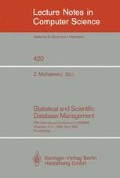Abstract
The Small Area Health Statistics Unit (SAHSU) has been established at the London School of Hygiene and Tropical Medicine (LSHTM) to investigate the geographical distribution of some diseases in the UK. The brief is to hold data on events (including death and cancer registration) identified by geographical location, and to produce event rates and analyses based on arbitrary geographical or administrative aggregations around industrial installations or other points. Events and population counts are associated with very small areas (an irregular tessellation) for which a point coordinate location is available.
Administrative areas form several membership hierarchies, for which the relational model provides a natural retrieval structure. Efficient retrievals for arbitrary geographical areas are achieved through the use of a regular tessellation overlay (grid-squares) as an intermediate step.
Output from the system is as a display of a classified table of rates, or as a file of records (for each aggregate area and sub-group) for further analysis in a statistical package.
Preview
Unable to display preview. Download preview PDF.
8. References
Investigation of the Possible Increased Incidence of Cancer in West Cumbria. Report of the Independent Advisory Group (Chairman, Sir Douglas Black). London: HM Stationery Office, 1984.
P. Elliot, (Ed). Methodology of Enquiry into Disease Clustering. Small Area Health Statistics Unit, LSHTM, March 1989.
M. Hills and F. Alexander. Statistical methods used in assessing the risk of disease near a source of possible environmental pollution: a review. Royal Statistical Society (A), 152(3)353, 1989.
J. Hogg. Representing Spatial Data by Linear Quadtrees. Computing, March 10, 1988.
I. Kleinschmidt. The SAHSU Prototype Computer System. Technical Note TN/012, Small Area Health Statistics Unit, LSHTM, January 1989.
R. Laurini and F. Milleret. Spatial Data Base Queries: Relational Algebra versus Computational Geometry. In [RaKS89].
R. Laurini. Manipulation of Spatial Objects with a Peano Tuple Algebra. University of Maryland, Centre for Automation Research Technical Report (1987).
M. Rafanelli, J. Klensin and P. Svensson (Eds.). Statistical and Scientific Database Management, IV SSDBM. Lecture Notes in Computer Science, Vol 339, Springer Verlag, 1989.
D. Rhind, S. Openshaw and N. Green. The analysis of Geographical Data: Data rich, Technology adequate, Theory poor. In [RaKS89].
Precision-Time Tradeoffs: a paradigm for processing statistical queries on databases. In [RaKS89].
A. J. Westlake. Some observations on the Statistical Uses of Geographical Information. Technical Note TN/010, Small Area Health Statistics Unit, LSHTM, June 1988.
A. J. Westlake (Ed). Geographical Database Systems and Statistical Information. In [RaKS89]
Author information
Authors and Affiliations
Editor information
Rights and permissions
Copyright information
© 1990 Springer-Verlag Berlin Heidelberg
About this paper
Cite this paper
Westlake, A.J., Kleinschmidt, I. (1990). The implementation of area and membership retrievals in point geography using SQL. In: Michalewicz, Z. (eds) Statistical and Scientific Database Management. SSDBM 1990. Lecture Notes in Computer Science, vol 420. Springer, Berlin, Heidelberg. https://doi.org/10.1007/3-540-52342-1_29
Download citation
DOI: https://doi.org/10.1007/3-540-52342-1_29
Published:
Publisher Name: Springer, Berlin, Heidelberg
Print ISBN: 978-3-540-52342-0
Online ISBN: 978-3-540-46968-1
eBook Packages: Springer Book Archive

